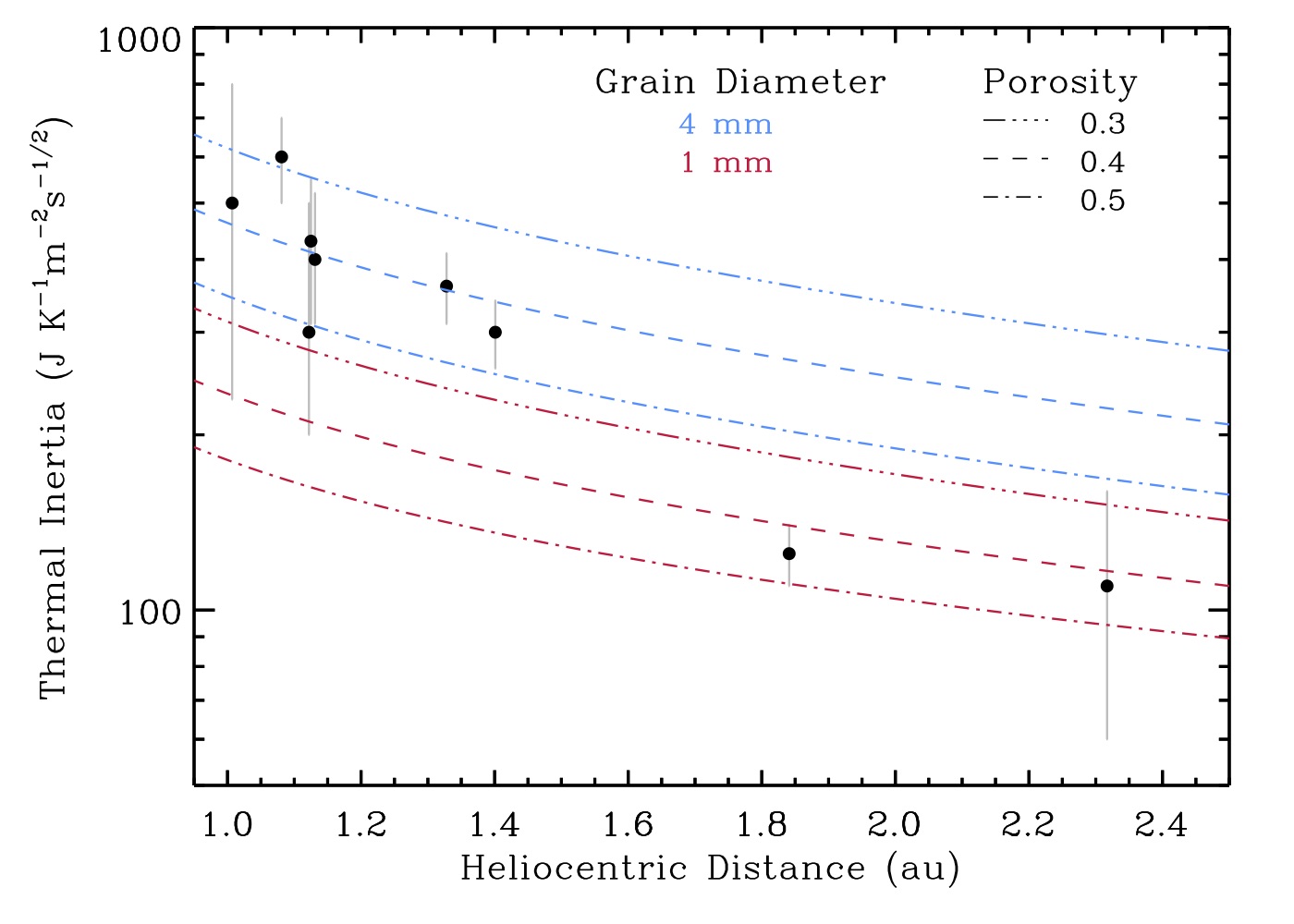Evidence for Regolith Heterogeneity on (3200) Phaethon
- 1Department of Physics, University of Helsinki, Finland (eric.maclennan@helsinki.fi)
- 2Arecibo Observatory & University of Central Florida
- 3Luleå University of Technology
The near-Earth asteroid (3200) Phaethon is classified as an active asteroid and is one of the largest objects with a perihelion within the orbit of Mercury. A dust tail has been observed during each of the last 3 closest approaches with the Sun. The activity, which is likely not driven by volatile sublimation, strongly suggests that Phaethon is the most likely parent body of the annual Geminid meteor shower. Phaethon is the main target for the JAXA DESTINY+ mission that will measure the dust environment, among other goals.
Regolith properties in the near-surface of asteroid can be inferred from the thermal inertia, Γ = √kρc. The effective thermal conductivity, k, is the most influential controlling factor in thermal inertia, as opposed to heat capacity (c) and bulk density (ρ). The effective thermal conductivity can expressed as a sum of the radiative conductivity and solid conductivity, which are controlled by the grain size and porosity of the regolith: specifically, the conduction through contacts through the regolith grains and the radiative transfer within the pores between them. Gundlach and Blum (2013) presented a thermal conductivity model that accurately models both these effects for planetary regoliths.
Because the radiative component of conductivity is temperature dependent (T3) it implies that thermal inertia is also temperature dependent. By extension, the strong inverse dependence that temperature has on heliocentric distance means that thermal inertia will increase with decreasing heliocentric distance. Rozitis et al., (2018) calculated this dependence for 3 NEAs: (1036) Ganymed, (1580) Betulia, and (276049) 2002 CE26. They found a wide variation in the variability, with Ganymed showing a strong dependence and Betulia showing a weak dependence.
The thermal inertia of Phaethon was previously estimated to be 600 ± 200 J m-2 K-1 s-1/2 by Hanus et al. (2018) and 880+580-330 J m-2 K-1 s-1/2 by Masiero et al. (2019). While Hanus et al. (2018) used a convex shape model derived from lightcurve inversion techniques, Masiero et al. (2019) used assumed a spherical shape. Furthermore these two different thermal inertia estimates were derived using two distinct datatsets: thermal emission spectrum from Spitzer and photometric data from IRAS and UKIRT Green et al (1995) was used by Hanus et al. (2018) and 5 epochs of WISE/NEOWISE photometry was used by Masiero et al. (2019). Both of these works alos reported diameter estimates of Phaethon (~5.1 and ~4.6 km) that are noticeably smaller than the reported effective diameter from delay-Doppler radar observations (5.5 - 6 km; Taylor et al. 2017).
Using a radar-derived shape model and thermal infrared observations from 10 observing epochs, we estimate Phaethon's thermal inertia for each epoch. We independently derive an effective diameter of ~5.5-5.6 km that is consistent with the radar observations and find that Phaethon's thermal inertia increases with decreasing heliocentric distance. Using the regolith thermal conductivity model presented by Gundlach and Blum (2013), we model the thermal inertia as a function of heliocentric distance for various grain sizes and porosities (Figure 1). We find that larger grain sizes are consistent with smaller heliocentric distances and smaller grain sizes are consistent with larger heliocentric distances.

Figure 1. Phaethon's thermal inertia as a function of heliocentric distance (black points) and modeled thermal inertia for different regoolith grain sizes and porosities.
We consider two other possibilities for Phaethon's regolith: 1) a depth-dependent layered model and 2) a two component latitude-dependnt model. The layered model consists of a fine-grained regolith covering solid bedrock and the two component model consists of two distinct grain sizes for each of Phaethon's northern and southern hemispheres. The effective thermal inertia of the layered regolith model exhibits a stronger dependence on heliocentric distance, as expected, but does not fit the observed thermal inertia estimates well. On the other hand, the model that consisters distinct grain sizes is very consistent with Phaethon's observed thermal inertia. We conclude that Phaethon's northern hemisphere consists of larger regolith grains compared to its southern hemisphere.
How to cite: MacLennan, E., Marshall, S., and Granvik, M.: Evidence for Regolith Heterogeneity on (3200) Phaethon, European Planetary Science Congress 2021, online, 13–24 Sep 2021, EPSC2021-804, https://doi.org/10.5194/epsc2021-804, 2021.

